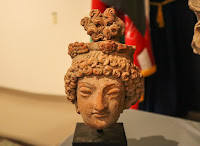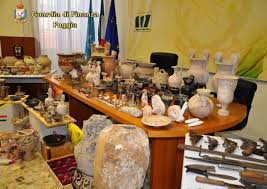 antiquities looting,antiquities recovered,arrest,Egypt,illicit excavation,Middle Kingdom,Minya,Zawiya Sultan
antiquities looting,antiquities recovered,arrest,Egypt,illicit excavation,Middle Kingdom,Minya,Zawiya Sultan
 No comments
No comments
577 Antiquities Seized: Minya looting case exposes ongoing threats to Egypt’s heritage
Egyptian authorities report the seizure of 577 artefacts in the Minya governorate in Upper Egypt, spanning the Middle Kingdom, Late Period, and Greco-Roman eras of ancient Egyptian history.
The operation was conducted by the General Administration of Tourism and Antiquities Investigations, coordinated with the Public Security Sector and the Criminal Investigation Department, under the oversight of senior law enforcement officers Major General Mohamed Ragab and Major General Mohamed Zein. As a result of this investigation, a search warrant was executed not far from Lotus University at the residence of Islam A.M., an appliance dealer. This resulted in the recovery of this large grouping of artefacts ,as well as the arrest of their intended seller, whose name was not given in full.
The ancient objects seized include this decorated 60-centimeter painted and gessoed wooden statue of a woman carrying offerings on her head, a cylindrical wooden image of Bes, the fertility god, and a basalt statue of Horus, missing its head from ancient erosion.
Other notable objects include a painted pottery statue, and a green stone carving depicting four women. Wood and faience ushabti figures suggest that at least some of the artefacts were looted from funerary contexts.
In addition to these, 503 silver and bronze coins, were discovered, pointing to a diverse cache of both ritual and utilitarian items.
According to Egyptian news sites, preliminary evaluation by antiquities inspectors confirm the authenticity of the artefacts seized as well as their protection under Egypt’s Antiquities Protection Law No. 117 of 1983.
Following his arrest, the suspect confessed to prospecting and illegal excavations in the Zawiya Sultan area, an archaeologically rich but vulnerable region east of the Nile. His admission underscores the continuing role of subsistence digging and opportunistic looting in feeding the illicit trade.Like many such cases, the looter's intent was to sell the objects on the black market, where demand for Egyptian antiquities internationally remains high, forcing looters to plunder remote locations or utilise creative means to avoid having their illicit excavation activities detected.
In 2024 residents of Minya Governorate, especially those who bury their contemporary loved ones in the cemeteries in Zawiyat Sultan, Al-Matahira, and the Cairo-Assiut Desert Road, complained to the authorities that thieves were stealing the metal doors of tombs and that graves were being broken into. It was discovered that gaining access to these modern internment spaces allowed looters to dig deep holes undetected in search of antiquities.
The richness of the Minya Governorate is well known. In April 2017, Nedjemankh’s famous golden coffin flew to New York on American Airlines after it was looted from the Minya region in October 2011.
In 2016, A'srāwy Kāmel Jād, a site guard was shot dead by looters, while a second watchman, Ali Khalaf Shāker, who was also on duty was gravely wounded and succumbed to his injuries later. The pair had been on duty protecting Deir el-Bersha an archaeological site located on the east bank of the Nile, south of Hermopolis, which is part of the same governorate.
For those thinking of taking up looting as a hobby, it should be remembered that Article 41 of Egypt's antiquities law stipulates that anyone who smuggles an antiquity out of the country or participates in smuggling it shall be punished by hard labor and a fine of no less than 5,000 Egyptian pounds and no more than 50,000 Egyptian pounds. Article 42 stipulates that anyone who steals or conceals an antiquity or part of an antiquity owned by a state shall be punished by imprisonment for a period of no less than 5 years.












































